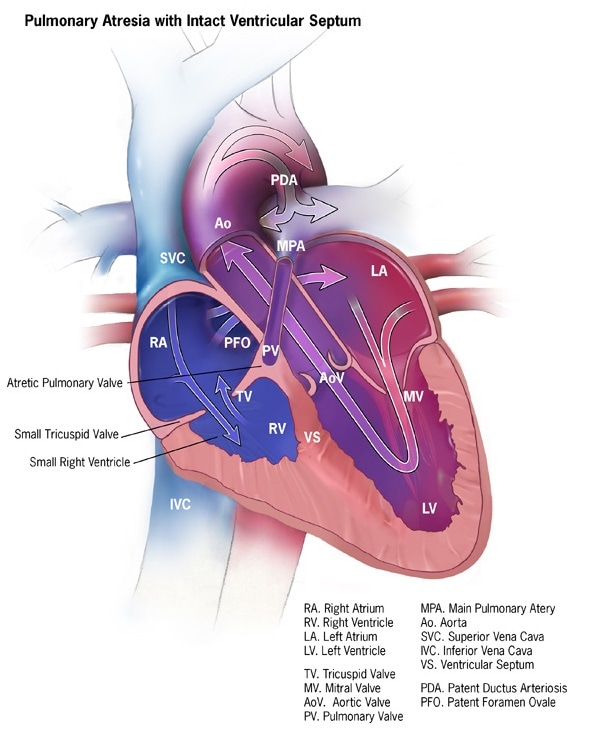The term ‘pulmonary’ refers to the lungs and ‘atresia’ means missing, so pulmonary atresia is a congenital heart defect in which the pulmonary valve of the infant is missing. The pulmonary valve regulates the flow of blood from the right ventricle in the heart to the lungs, taking blood low in oxygen and passing it on to the lungs to make it oxygen rich.
In an infant born with pulmonary atresia, the pulmonary valve does not develop. Instead, a solid sheet of tissue exists where the valve should be. This effectively blocks the flow of blood. As a result of this birth defect, the infant suffers from a lack of oxygen-rich blood, which can be fatal. The condition often requires surgery soon after birth and is called a critical congenital heart defect.

Visible Symptoms and Complications
Noticeable symptoms in a newborn with pulmonary atresia can become evident within a few hours of birth or they may be delayed for several days, depending on the type and severity of the condition. The symptoms could include:
- Cyanosis or bluish gray tinged skin, lips or nails
- Shortness of breath or quick breathing
- Getting tired easily or being lethargic
- Not feeding well or getting fatigued while nursing
- Clammy and sweaty skin that is cool to the touch
A number of complications may arise from this condition. The baby will be at risk for seizures, strokes, or heart failure. The baby may also experience delayed growth and development, or infectious endocarditis. It is imperative that pulmonary atresia is identified as soon as possible for the baby to survive. If not treated the condition will prove fatal.
Diagnosis of Pulmonary Atresia
A neonatologist or pediatric cardiologist will be consulted to diagnose pulmonary atresia. There are two variations of the condition depending on whether a ventricular septal defect is present. The diagnostic tests may include:
- Chest X-ray that allows the doctor to view the internal tissues, bones and organs
- Echocardiogram that records the electrical activity of the heart to highlight abnormal rhythms and heart muscle stress
- Electrocardiogram or ECG that evaluates the structure and function of the heart using sound waves to produce a moving picture of the heart and it’s valves
- Cardiac catheterization where a thin, flexible tube is inserted into a blood vessel in the groin and is guided inside the heart to visualize the structure and monitor it’s functioning
- Pulse oximetry that tests the amount of oxygen that is present in the blood of the baby
Causes of Pulmonary Atresia
The exact cause of this congenital heart defect is not known, but a number of risk factors that may cause the condition have been delineated. The risk of the baby being born with pulmonary atresia increases if the pregnant mother has suffered from rubella or any other viral infection during early pregnancy.
Drinking or smoking during pregnancy also increases the risk of a congenital heart defect. Mothers who have diabetes or suffer from an autoimmune disease called lupus, have a higher chance of bearing babies with Pulmonary Atresia. The use of medications for bipolar disorder, acne drug isotretinoin, or anti-seizure medication during pregnancy can also increase the risk.
Those parents who have had a congenital heart defect may also pass on the faulty gene to the baby. As there is no way to identify the exact cause of pulmonary atresia, there is no way to prevent it. Pregnant mothers can only be advised about the risk and asked to take care of any chronic medical condition they suffer from.
Treatment of Pulmonary Atresia
The ductus arteriosus is present in normal fetuses and circulates blood between the heart and lungs while in the womb. It usually closes sometime after the baby’s birth. For those born with pulmonary atresia, an intravenous medicine called prostaglandin E1 is used to keep the ductus arteriosus from closing. This provides an alternative for blood circulation till the pulmonary valve is surgically fixed.
There are different possible surgical solutions to pulmonary atresia. Initially a heart catheterization may be performed, wherein a tube is inserted with a balloon to create an opening in the atrial septum or the wall between the left and right atria. This allows the blood to mix between the two chambers and the oxygen level of the heart to stabilise.
Surgical repair of the condition could include open heart surgery to repair or replace the pulmonary valve. Alternatively, a tube may be placed from the right ventricle to the pulmonary arteries to aid blood flow. In some cases, the surgeon may reconstruct the heart as a single ventricle by removing the atrial septum completely.
The exact nature of the surgery will be based on the patient’s condition. Surgery is recommended as soon as possible after birth to ensure that the baby has a good chance of recovery.
References
- http://www.cdc.gov/ncbddd/heartdefects/pulmonaryatresia.html
- https://medlineplus.gov/ency/article/001091.htm
- http://www.mayoclinic.org/diseases-conditions/pulmonary-atresia/home/ovc-20179584
- http://www.chd-uk.co.uk/types-of-chd-and-operations/pulmonary-atresia-pa/
- http://www.childrenshospital.org/conditions-and-treatments/conditions/pulmonary-atresia
- http://www.stanfordchildrens.org/en/topic/default?id=pulmonary-atresia-pa-90-P01809
Further Reading
- All Pulmonary Atresia Content
- Treatment for Pulmonary Atresia
Last Updated: Feb 27, 2019

Written by
Cashmere Lashkari
Cashmere graduated from Nowrosjee Wadia College, Pune with distinction in English Honours with Psychology. She went on to gain two post graduations in Public Relations and Human Resource Training and Development. She has worked as a content writer for nearly two decades. Occasionally she conducts workshops for students and adults on persona enhancement, stress management, and law of attraction.
Source: Read Full Article
